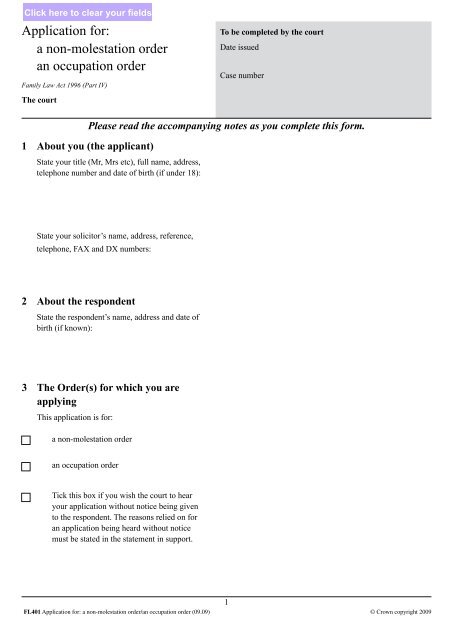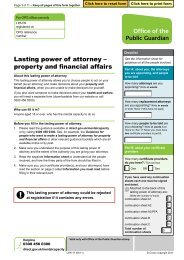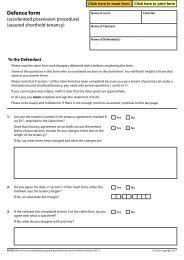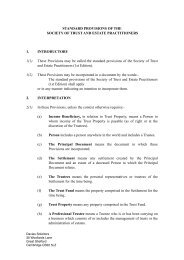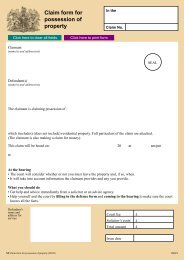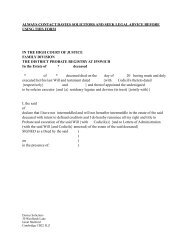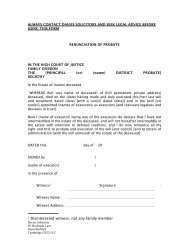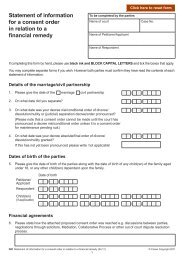Application for: a non-molestation order an occupation ... - Family Law
Application for: a non-molestation order an occupation ... - Family Law
Application for: a non-molestation order an occupation ... - Family Law
You also want an ePaper? Increase the reach of your titles
YUMPU automatically turns print PDFs into web optimized ePapers that Google loves.
13 One of you is the natural parent orgr<strong>an</strong>dparent of a child adopted, placed or freed<strong>for</strong> adoption, <strong>an</strong>d the other is:(i) the adoptive parentor (ii) a person who has applied <strong>for</strong> <strong>an</strong>adoption <strong>order</strong> <strong>for</strong> the childor (iii) a person with whom the child hasbeen placed <strong>for</strong> adoptionor (iv) the child who has been adopted,placed or freed <strong>for</strong> adoption.State whether (i), (ii), (iii) or (iv):14 Both of you are the parties to the same familyproceedings (see also Section 11 below).5 <strong>Application</strong> <strong>for</strong> a <strong>non</strong>-<strong>molestation</strong> <strong>order</strong>If you wish to apply <strong>for</strong> a <strong>non</strong>-<strong>molestation</strong> <strong>order</strong>,state briefly in this section the <strong>order</strong> you w<strong>an</strong>t.Give full details in support of your application inyour supporting evidence.6 <strong>Application</strong> <strong>for</strong> <strong>an</strong> <strong>occupation</strong> <strong>order</strong>If you do not wish to apply <strong>for</strong> <strong>an</strong> <strong>occupation</strong> <strong>order</strong>,please go to section 9 of this <strong>for</strong>m.(A) State the address of the dwelling-house to whichyour application relates:(B) State whether it is occupied by you or the respondentnow or in the past, or whether it was intended to beoccupied by you or the respondent:(C) State whether you are entitled to occupy thedwelling-house: Yes NoIf yes, explain why:3
(D) State whether the respondent is entitled to occupythe dwelling-house: Yes NoIf yes, explain why:On the basis of your <strong>an</strong>swers to (C) <strong>an</strong>d (D) above,tick one of the boxes 1 to 6 below to show the categoryinto which you fit1 a spouse or civil partner who has home rightsin the dwelling-house, or a person who isentitled to occupy it by virtue of a beneficialestate or interest or contract or by virtue of<strong>an</strong>y enactment giving him or her the right toremain in <strong>occupation</strong>.If you tick box 1, state whether there is adispute or pending proceedings between you<strong>an</strong>d the respondent about your right to occupythe dwelling-house.2 a <strong>for</strong>mer spouse or <strong>for</strong>mer civil partner with noexisting right to occupy, where the respondentspouse or civil partner is so entitled.3 a cohabit<strong>an</strong>t or <strong>for</strong>mer cohabit<strong>an</strong>t with noexisting right to occupy, where the respondentcohabit<strong>an</strong>t or <strong>for</strong>mer cohabit<strong>an</strong>t is so entitled.4 a spouse or <strong>for</strong>mer spouse who is not entitledto occupy, where the respondent spouse or<strong>for</strong>mer spouse is also not entitled.5 a civil partner or <strong>for</strong>mer civil partner who is notentitled to occupy, where the respondent civilpartner or <strong>for</strong>mer civil partner is also not entitled.6 a cohabit<strong>an</strong>t or <strong>for</strong>mer cohabit<strong>an</strong>t who isnot entitled to occupy, where the respondentcohabit<strong>an</strong>t or <strong>for</strong>mer cohabit<strong>an</strong>t is also notentitled.4
Home RightsIf you do have home rights please:State whether the title to the l<strong>an</strong>d is registered orunregistered (if known):If registered, state the L<strong>an</strong>d Registry title number(if known):If you wish to apply <strong>for</strong> <strong>an</strong> <strong>occupation</strong> <strong>order</strong>, statebriefly here the <strong>order</strong> you w<strong>an</strong>t. Give full detailsin support of your application in your supportingevidence:7 <strong>Application</strong> <strong>for</strong> additional <strong>order</strong>(s)about the dwelling-houseIf you w<strong>an</strong>t to apply <strong>for</strong> <strong>an</strong>y of the <strong>order</strong>s listed inthe notes to this section, state what <strong>order</strong> you wouldlike the court to make:8 Mortgage <strong>an</strong>d rentIs the dwelling-house subject to a mortgage?YesNoIf yes, please provide the name <strong>an</strong>d address of themortgagee:Is the dwelling-house rented?YesNoIf yes, please provide the name <strong>an</strong>d address of thel<strong>an</strong>dlord:5
9 At the courtWill you need <strong>an</strong> interpreter at court?YesNoIf yes, specify the l<strong>an</strong>guage:If you require <strong>an</strong> interpreter, you must notify thecourt immediately so that one c<strong>an</strong> be arr<strong>an</strong>ged.If you have a disability <strong>for</strong> which you require specialassist<strong>an</strong>ce or special facilities, please state what yourneeds are. The court staff will get in touch with youabout your requirements.10 Other in<strong>for</strong>mationState the name <strong>an</strong>d date of birth of <strong>an</strong>y child livingwith or staying with, or likely to live with or staywith, you or the respondent:State the name of <strong>an</strong>y other person living in the samehousehold as you <strong>an</strong>d the respondent, <strong>an</strong>d say whythey live there:11 Other Proceedings <strong>an</strong>d OrdersIf there are <strong>an</strong>y other current family proceedings or<strong>order</strong>s in <strong>for</strong>ce involving you <strong>an</strong>d the respondent,state the type of proceedings or <strong>order</strong>s, the court <strong>an</strong>dthe case number. This includes <strong>an</strong>y application <strong>for</strong><strong>an</strong> <strong>occupation</strong> <strong>order</strong> or <strong>non</strong>-<strong>molestation</strong> <strong>order</strong> againstyou by the respondent.This application is to be served upon the respondentSigned:Date:6
<strong>Application</strong> <strong>for</strong> <strong>non</strong>-<strong>molestation</strong> <strong>order</strong> or <strong>occupation</strong> <strong>order</strong>Notes <strong>for</strong> guid<strong>an</strong>ceSection 1If you do not wish your address to be made known to therespondent, leave the space on the <strong>for</strong>m bl<strong>an</strong>k <strong>an</strong>d completeConfidential Address Form C8. The court c<strong>an</strong> give you this <strong>for</strong>m.If you are under 18, someone over 18 must help you make thisapplication. That person, who might be one of your parents, iscalled a ‘next friend’.If you are under 16, you need permission to make thisapplication. You must apply to the High Court <strong>for</strong> permission,using this <strong>for</strong>m. If the High Court gives you permission to makethis application, it will then either hear the application itself ortr<strong>an</strong>sfer it to a county court.Section 3An urgent <strong>order</strong> made by the court be<strong>for</strong>e the notice of theapplication is served on the respondent is called <strong>an</strong> ex-parte <strong>order</strong>.In deciding whether to make <strong>an</strong> ex-parte <strong>order</strong> the court willconsider all the circumst<strong>an</strong>ces of the case, including:• <strong>an</strong>y risk of signific<strong>an</strong>t harm to the applic<strong>an</strong>t or a relev<strong>an</strong>tchild, attributable to conduct of the respondent, if the <strong>order</strong>is not made immediately• whether it is likely that the applic<strong>an</strong>t will be deterred orprevented from pursuing the application if <strong>an</strong> <strong>order</strong> is notmade immediately• whether there is reason to believe that the respondent isaware of the proceedings but is deliberately evading service<strong>an</strong>d that the applic<strong>an</strong>t or a relev<strong>an</strong>t child will be seriouslyprejudiced by the delay involved.If the court makes <strong>an</strong> ex-parte <strong>order</strong>, it must give the respondent<strong>an</strong> opportunity to make representations about the <strong>order</strong> as soon asjust <strong>an</strong>d convenient at a full hearing.‘Harm’ in relation to a person who has reached the age of 18me<strong>an</strong>s ill-treatment or the impairment of health, <strong>an</strong>d in relationto a child me<strong>an</strong>s ill-treatment or the impairment of health <strong>an</strong>ddevelopment.‘Ill-treatment’ includes <strong>for</strong>ms of ill-treatment which are notphysical <strong>an</strong>d, in relation to a child, includes sexual abuse. Thecourt will require evidence of <strong>an</strong>y harm which you allege insupport of your application.Section 4For you to be able to apply <strong>for</strong> <strong>an</strong> <strong>order</strong> you must be related to therespondent in one of the ways listed in this section of the <strong>for</strong>m. If youare not related in one of these ways you should seek legal advice.Cohabit<strong>an</strong>ts are two persons who, although not married to eachother, nor civil partners of each other, are living together ashusb<strong>an</strong>d <strong>an</strong>d wife or civil partners. People who have cohabited,but have then married or <strong>for</strong>med a civil partnership will not fallwithin this category but will fall within the category of marriedpeople or people who are civil partners of each other.1Those who live or have lived in the same household do notinclude people who share the same household because one ofthem is the other’s employee, ten<strong>an</strong>t, lodger or boarder.You will only be able to apply as a relative of the respondentif you are:(A) the father, mother, stepfather, stepmother, son, daughter,stepson, stepdaughter, gr<strong>an</strong>dmother, gr<strong>an</strong>dfather, gr<strong>an</strong>dson,gr<strong>an</strong>ddaughter of the respondent or of the respondent’s spouse,<strong>for</strong>mer spouse, civil partner or <strong>for</strong>mer civil partner.(B) the brother, sister, uncle, aunt, niece, nephew or first cousin(whether of the full blood or of the half blood or by marriageor by civil partnership) of the respondent or of the respondent’sspouse, <strong>for</strong>mer spouse, civil partner or <strong>for</strong>mer civil partner.This includes, in relation to a person who is living or has livedwith <strong>an</strong>other person as husb<strong>an</strong>d <strong>an</strong>d wife or as civil partners,<strong>an</strong>y person who would fall within (A) or (B) if the parties weremarried to, or civil partners of, each other (<strong>for</strong> example, yourcohabitee’s father or brother).Agreements to marry: You will fall within this category only ifyou make this application within three years of the termination ofthe agreement. The court will require the following evidence ofthe agreement:ororevidence in writingthe gift of <strong>an</strong> engagement ring in contemplation of marriageevidence that a ceremony has been entered into in thepresence of one or more other persons assembled <strong>for</strong> thepurpose of witnessing it.Agreements to <strong>for</strong>m a civil partnership: You will fall withinthis category only if you make this application within three yearsof the termination of the agreement. The court will require thefollowing evidence of the agreement:ororevidence in writinga gift from one party to the agreement to the other as a tokenof the agreementevidence that a ceremony has been entered into in thepresence of one or more other persons assembled <strong>for</strong> thepurpose of witnessing it.Parents <strong>an</strong>d parental responsibility:You will fall within this category ifboth you <strong>an</strong>d the respondent are either the parents of thechild or have parental responsibility <strong>for</strong> that childorif one of you is the parent <strong>an</strong>d the other has parentalresponsibility.
Section 4 continuedUnder the Children Act 1989, parental responsibility is heldautomatically by a child’s mother, <strong>an</strong>d by the child’s father ifhe <strong>an</strong>d the mother were married to each other at the time of thechild’s birth or have married subsequently. Where, a child’sfather <strong>an</strong>d mother are not married to each other at the time of thechild’s birth, the father may also acquire parental responsibility<strong>for</strong> that child, if he registers the birth after 1st December 2003, inaccord<strong>an</strong>ce with section 4(1)(a) of the Children Act 1989. Whereneither of these circumst<strong>an</strong>ces apply, the father, in accord<strong>an</strong>cewith the provisions of the Children Act 1989, c<strong>an</strong> acquire parentalresponsibility.From 30 December 2005, where a person who is not the child’sparent (“the step-parent”) is married to, or a civil partner of,a parent who has parental responsibility <strong>for</strong> that child, he orshe may also acquire parental responsibility <strong>for</strong> the child inaccord<strong>an</strong>ce with the provisions of the Children Act 1989.From 1st September 2009, specific provision has beenmade in relation to parental responsibility in certain casesinvolving assisted reproduction. Parental responsibility is heldautomatically by a wom<strong>an</strong> if—• she <strong>an</strong>d the child’s mother were in a civil partnership witheach other at the time of treatment unless that wom<strong>an</strong> didnot consent to the treatment; or• she is a parent of the child by virtue of section 43 ofthe Hum<strong>an</strong> Fertilisation <strong>an</strong>d Embryology Act 2008 <strong>an</strong>dsubsequently enters into a civil partnership with the mother.A wom<strong>an</strong> who is a parent of the child by virtue of section 43 ofthe 2008 Act but who does not subsequently enter into a civilpartnership with the mother may acquire parental responsibilityin accord<strong>an</strong>ce with the provisions of section 4ZA of the ChildrenAct 1989Section 5A <strong>non</strong>-<strong>molestation</strong> <strong>order</strong> c<strong>an</strong> <strong>for</strong>bid the respondent frommolesting you or a relev<strong>an</strong>t child. Molestation c<strong>an</strong> include,<strong>for</strong> example, violence, threats, pestering <strong>an</strong>d other <strong>for</strong>msof harassment. The court c<strong>an</strong> <strong>for</strong>bid particular acts of therespondent, <strong>molestation</strong> in general, or both.Section 6If you wish to apply <strong>for</strong> <strong>an</strong> <strong>occupation</strong> <strong>order</strong> but you areuncertain about your <strong>an</strong>swer to <strong>an</strong>y question in this part ofthe application <strong>for</strong>m, you should seek legal advice.(A) A dwelling-house includes <strong>an</strong>y building or part of a buildingwhich is occupied as a dwelling; <strong>an</strong>y carav<strong>an</strong>, houseboat orstructure which is occupied as a dwelling; <strong>an</strong>d <strong>an</strong>y yard, garden,garage or outhouse belonging to it <strong>an</strong>d occupied with it.(C) & (D) The following questions give examples to help youto decide if you or the respondent, or both of you, are entitled tooccupy the dwelling-house:(a) Are you the sole legal owner of the dwelling-house?(b) Are you <strong>an</strong>d the respondent joint legal owners of thedwelling-house?(c) Is the respondent the sole legal owner of the dwelling-house?(d) Do you rent the dwelling-house as a sole ten<strong>an</strong>t?(e) Do you <strong>an</strong>d the respondent rent the dwelling-house as jointten<strong>an</strong>ts?(f)Does the respondent rent the dwelling-house as a sole ten<strong>an</strong>t?If you <strong>an</strong>swer ―• Yes to (a), (b), (d) or (e) you are likely to be entitled tooccupy the dwelling-house• Yes to (c) or (f) you may not be entitled (unless, <strong>for</strong> example,you are a spouse or civil partner <strong>an</strong>d have home rights – seenotes under ‘Home Rights’ below)• Yes to (b), (c), (e) or (f), the respondent is likely to beentitled to occupy the dwelling-house• Yes to (a) or (d) the respondent may not be entitled (unless,<strong>for</strong> example, he or she is a spouse or civil partner <strong>an</strong>d hashome rights).Box 1 For example, if you are sole owner, joint owner or if yourent the property. If you are not a spouse, <strong>for</strong>mer spouse, civilpartner, <strong>for</strong>mer civil partner, cohabit<strong>an</strong>t or <strong>for</strong>mer cohabit<strong>an</strong>t ofthe respondent, you will only be able to apply <strong>for</strong> <strong>an</strong> <strong>occupation</strong><strong>order</strong> if you fall within this category.If you <strong>an</strong>swer yes to this question, it will not be possible <strong>for</strong> amagistrates’ court to deal with the application, unless the courtdecides that it is unnecessary <strong>for</strong> it to decide this question in<strong>order</strong> to deal with the application or make the <strong>order</strong>. If the courtdecides that it c<strong>an</strong>not deal with the application, it will tr<strong>an</strong>sfer theapplication to a county court.Box 2 For example, if the respondent is or was married to you, orif you <strong>an</strong>d the respondent are or were civil partners, <strong>an</strong>d he or sheis sole owner or rents the property.Box 3 For example, if the respondent is or was cohabiting withyou <strong>an</strong>d is sole owner or rents the property.Home RightsWhere one spouse or civil partner “(A)” is entitled to occupythe dwelling-house by virtue of a beneficial estate or interest orcontract or by virtue of <strong>an</strong>y enactment giving him or her the rightto remain in <strong>occupation</strong>, <strong>an</strong>d the other spouse or civil partner “(B)”is not so entitled, then B (who is not entitled) has home rights.The rights are―(a) if B is in <strong>occupation</strong>, not to be evicted or excluded from thedwelling-house except with the leave of the court; <strong>an</strong>d(b) if B is not in <strong>occupation</strong>, the right, with the leave of thecourt, to enter into <strong>an</strong>d occupy the dwelling-house.2
Section 6 (continued)Note: Home Rights do not exist if the dwelling-house has neverbeen, <strong>an</strong>d was never intended to be, the matrimonial or civilpartnership home of the two spouses or civil partners. If themarriage or civil partnership has come to <strong>an</strong> end, home rightswill also have ceased, unless a court <strong>order</strong> has been made duringthe marriage or civil partnership <strong>for</strong> the rights to continue afterthe end of that relationship.Occupation OrdersThe possible <strong>order</strong>s are:If you have ticked box 1 above, <strong>an</strong> <strong>order</strong> under section 33 of theAct may:• en<strong>for</strong>ce the applic<strong>an</strong>t’s entitlement to remain in <strong>occupation</strong>as against the respondent• require the respondent to permit the applic<strong>an</strong>t to enter <strong>an</strong>dremain in the dwelling-house or part of it• regulate the <strong>occupation</strong> of the dwelling-house by either orboth parties• if the respondent is also entitled to occupy, the <strong>order</strong> mayprohibit, suspend or restrict the exercise by him, of that right• restrict or terminate <strong>an</strong>y home rights of the respondent• require the respondent to leave the dwelling-house or part of it• exclude the respondent from a defined area around thedwelling-house• declare that the applic<strong>an</strong>t is entitled to occupy the dwellinghouseor has home rights in it• provide that the home rights of the applic<strong>an</strong>t are not broughtto <strong>an</strong> end by the death of the other spouse or civil partner ortermination of the marriage or civil partnership.If you have ticked box 2 or box 3 above, <strong>an</strong> <strong>order</strong> under section35 or 36 of the Act may:• give the applic<strong>an</strong>t the right not to be evicted or excludedfrom the dwelling-house or <strong>an</strong>y part of it by the respondent<strong>for</strong> a specified period• prohibit the respondent from evicting or excluding theapplic<strong>an</strong>t during that period• give the applic<strong>an</strong>t the right to enter <strong>an</strong>d occupy the dwellinghouse<strong>for</strong> a specified period• require the respondent to permit the exercise of that right• regulate the <strong>occupation</strong> of the dwelling-house by either orboth of the parties• prohibit, suspend or restrict the exercise by the respondent ofhis right to occupy• require the respondent to leave the dwelling-house or part of it• exclude the respondent from a defined area around thedwelling-house.If you have ticked box 4 or box 5 above, <strong>an</strong> <strong>order</strong> under section37 or 38 of the Act may:• require the respondent to permit the applic<strong>an</strong>t to enter <strong>an</strong>dremain in the dwelling-house or part of it• regulate the <strong>occupation</strong> of the dwelling-house by either orboth of the parties• require the respondent to leave the dwelling-house or part of it• exclude the respondent from a defined area around thedwelling-house.You should provide <strong>an</strong>y evidence which you have on thefollowing matters in your evidence in support of thisapplication. If necessary, further statements may besubmitted after the application has been issued.If you have ticked box 1, box 4 or box 5 above, the court willneed <strong>an</strong>y available evidence of the following:• the housing needs <strong>an</strong>d resources of you, the respondent <strong>an</strong>d<strong>an</strong>y relev<strong>an</strong>t child• the fin<strong>an</strong>cial needs of you <strong>an</strong>d the respondent• the likely effect of <strong>an</strong>y <strong>order</strong>, or <strong>an</strong>y decision not to make<strong>an</strong> <strong>order</strong>, on the health, safety <strong>an</strong>d well-being of you, therespondent <strong>an</strong>d <strong>an</strong>y relev<strong>an</strong>t child• the conduct of you <strong>an</strong>d the respondent in relation to eachother <strong>an</strong>d otherwise.If you have ticked box 2 above, the court will need <strong>an</strong>y availableevidence of:• the housing needs <strong>an</strong>d resources of you, the respondent <strong>an</strong>d<strong>an</strong>y relev<strong>an</strong>t child• the fin<strong>an</strong>cial resources of you <strong>an</strong>d the respondent• the likely effect of <strong>an</strong>y <strong>order</strong>, or of <strong>an</strong>y decision not to make<strong>an</strong> <strong>order</strong> on the health, safety <strong>an</strong>d well-being of you, therespondent <strong>an</strong>d <strong>an</strong>y relev<strong>an</strong>t child• the conduct of you <strong>an</strong>d the respondent in relation to eachother <strong>an</strong>d otherwise• the length of time that has elapsed since you <strong>an</strong>d therespondent ceased to live together• where you <strong>an</strong>d the respondent were married, the length oftime that has elapsed since the marriage was dissolved or<strong>an</strong>nulled• where you <strong>an</strong>d the respondent were civil partners, the lengthof time that has elapsed since the dissolution or <strong>an</strong>nulmentof the civil partnership3
Section 6 (continued)• the existence of <strong>an</strong>y pending proceedings between you <strong>an</strong>dthe respondent:under section 23A of the Matrimonial Causes Act 1973(property adjustment <strong>order</strong>s in connection with divorceproceedings etc.)orororunder Part 2 of Schedule 5 to the Civil PartnershipAct 2004 (property adjustment on or after dissolution,nullity or separation)under Schedule 1 para 1(2)(d) or (e) of the ChildrenAct 1989 (<strong>order</strong>s <strong>for</strong> fin<strong>an</strong>cial relief against parents)relating to the legal or beneficial ownership of thedwelling-house.If you have ticked box 3 above, the court will need <strong>an</strong>y availableevidence of:• the housing needs <strong>an</strong>d resources of you, the respondent <strong>an</strong>d<strong>an</strong>y relev<strong>an</strong>t child• the fin<strong>an</strong>cial resources of you <strong>an</strong>d the respondent• the likely effect of <strong>an</strong>y <strong>order</strong>, or of <strong>an</strong>y decision not to make<strong>an</strong> <strong>order</strong>, on the health, safety <strong>an</strong>d well-being of you, therespondent <strong>an</strong>d <strong>an</strong>y relev<strong>an</strong>t child• the conduct of you <strong>an</strong>d the respondent in relation to eachother <strong>an</strong>d otherwise• the nature of your <strong>an</strong>d the respondent’s relationship• the length of time during which you have lived together ashusb<strong>an</strong>d <strong>an</strong>d wife or civil partners• whether you <strong>an</strong>d the respondent have had <strong>an</strong>y children, orhave both had parental responsibility <strong>for</strong> <strong>an</strong>y children• the length of time that has elapsed since you <strong>an</strong>d therespondent ceased to live together• the existence of <strong>an</strong>y pending proceedings between you<strong>an</strong>d the respondent under Schedule 1 para 1(2)(d) or (e) ofthe Children Act 1989 or relating to the legal or beneficialownership of the dwelling-house.Section 7Under section 40 of the Act the court may make the followingadditional <strong>order</strong>s when making <strong>an</strong> <strong>occupation</strong> <strong>order</strong>:• impose on either party obligations as to the repair <strong>an</strong>dmainten<strong>an</strong>ce of the dwelling-house• impose on either party obligations as to the payment of rent,mortgage or other outgoings affecting it• <strong>order</strong> a party occupying the dwelling-house to makeperiodical payments to the other party in respect of theaccommodation, if the other party would (but <strong>for</strong> the <strong>order</strong>)be entitled to occupy it• gr<strong>an</strong>t either party possession or use of furniture or othercontents4• <strong>order</strong> either party to take reasonable care of <strong>an</strong>y furniture orother contents• <strong>order</strong> either party to take reasonable steps to keep thedwelling-house <strong>an</strong>d <strong>an</strong>y furniture or other contents secure.Section 8If the dwelling-house is rented or subject to a mortgage, thel<strong>an</strong>dlord or mortgagee must be served with notice of theproceedings in Form FL416. He or she will then be able to makerepresentations to the court regarding the rent or mortgage.Section 10A person living in the same household may, <strong>for</strong> example, bea member of the family or a ten<strong>an</strong>t or employee of you or therespondent.


